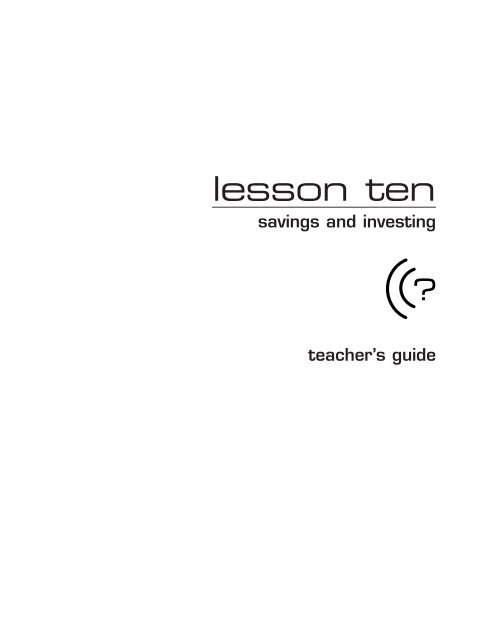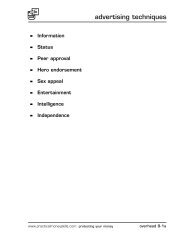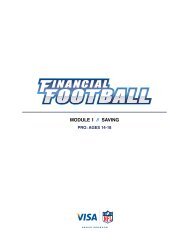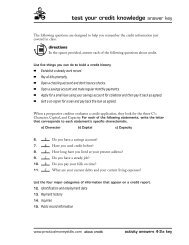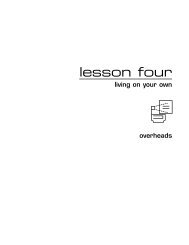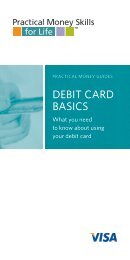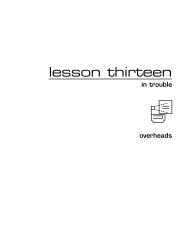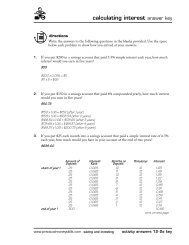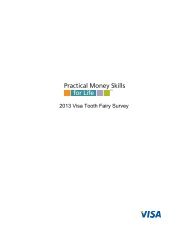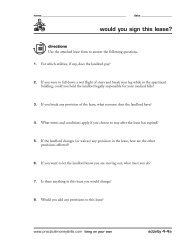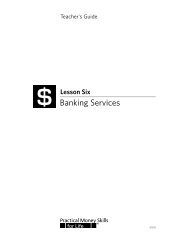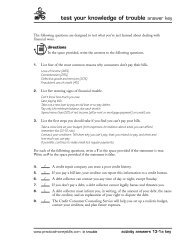lesson ten - Practical Money Skills
lesson ten - Practical Money Skills
lesson ten - Practical Money Skills
- No tags were found...
Create successful ePaper yourself
Turn your PDF publications into a flip-book with our unique Google optimized e-Paper software.
<strong>lesson</strong> <strong>ten</strong>savings and investingteacher’s guide
savings and investing web sitesweb sites for savings and investingThe Internet is probably the most ex<strong>ten</strong>sive and dynamic source of informationin our society. The following Web sites can provide students and others withcurrent information, assistance, and data related to this <strong>lesson</strong>. Web addressesending in “.com” are commercial sites; “.org” are non-profit sites; and “.gov” aregovernment sites.AboutAmerican Savings EducationCouncilAmerican Stock ExchangeBloombergBonds OnlineBureau of the Public Debt OnlineCNN <strong>Money</strong>Current Rates for SavingsInstrumentsFederal Deposit InsuranceCorporationInvestopedia.comInvestorguide.com<strong>Money</strong> LineMorningstarThe Motley FoolNASDAQwww.stocks.about.comwww.mutualfunds.about.comwww.asec.orgwww.amex.comwww.bloomberg.comwww.bonds-online.comwww.publicdebt.treas.gov/sav/sav.htmmoney.cnn.comwww.bankrate.comwww.banx.comwww.bankrate.com/ust/rate/dep_home.aspwww.fdic.govwww.investopedia.comwww.investorguide.comwww.moneyline.comwww.morningstar.comwww.fool.comwww.nasdaq.comNational Association of InvestorsCorporation: Investment Clubwww.practicalmoneyskills.com savings and investingteacher’s guide
savings and investing web sitesInformationNational Association ofSecurity DealersNew York Stock ExchangeRoth IRA InformationSmart<strong>Money</strong>Standard & Poor Personal WealthStock Quotes and Related DataTeenvestor.comTeenanalyst.comU.S. Securities & ExchangeCommissionwww.better-investing.orgwww.investor.nasd.comwww.nyse.comwww.rothira.comwww.smartmoney.comwww.personalwealth.comwww.wsrn.comwww.quote.comwww.teenvestor.comwww.teenanalyst.comwww.sec.govNote: Addresses and con<strong>ten</strong>t of Web sites change, and new sites are created daily. Use searchengines such as Yahoo, Google, AltaVista, Infoseek, Lycos, or Hotbot, to update and locate Websites related to this topic.www.practicalmoneyskills.com savings and investingteacher’s guide
cars and loans teaching notes10-1 The student will recognize the importance ofsaving and investing money to reach financial goals.what are your financial goals? how can youreach them?■■■■■■■■■■■Define the term “saving.”Define the term “investing.”Discuss the reasons why people save and investmoney.Talk about the importance of setting financialgoals. Give students examples of financial goals,such as “buy used car,” “save enough money forprom night,” or “double the amount of moneypresently in savings.”Define goals as short range (1-4 weeks),medium-range (2-12 months), or long-range(more than 1 year). Stress that people need tohave all three: short, medium, and long-rangegoals.Have students complete the Setting YourFinancial Goals worksheet (activity 10-1a). Ifstudents don’t have enough income to completethis exercise, give them a theoretical income towork with.Ask students to share some of their goals withthe class, including estimated costs, target dates,and the amounts they would need to save eachweek to meet their goals.Introduce the concept of making money grow.Emphasize that by understanding how interestrates work, students can make their money growfaster.Using overhead 10-1a, demonstrate how tocalculate simple interest. Show students how toconvert the interest rate into a decimal forcalculation purposes.Using overhead 10-1b, demonstrate how tocalculate compound interest. Remind studentshow to convert the interest rate into a decimalfor calculation purposes.Compare the results of simple and compoundinterest calculations. Discuss the advantage ofearning interest on interest to “grow money”faster.discussionstudent activity 10-1a:setting your financial goalsoverhead 10-1a:simple interest calculationoverhead 10-1b:compound interestcalculationstudent activity 10-1b:calculating interestwww.practicalmoneyskills.com savings and investing teacher’s guide 10-1
savings and investing teaching notes■■■Have students complete the Calculating Interestworksheet individually or in small groups(activity 10-1b). Review the answers and, asneeded, show the calculations on the board. (Youmay also allow them to use the online loancalculator.)Reemphasize how the interest rate and themethod of calculation affect how money grows.Explain that the compounding effect applies toany investment, not just a bank account.terms you should knowSaving — The process of setting aside money until a futuredate instead of spending it today. The goal of saving is toprovide funds for emergencies, short-term goals, andinvestments.Investing — The process of setting money aside to increasewealth over time and accumulate funds for long-termfinancial goals such as retirement.setting financial goals1. Why save?■ In case of an emergency■ To have the option of taking advantage ofunforeseen opportunities■ To reach financial goals2. Why set goals?■ Give direction for making plans and takingactions3. Set and prioritize your financial goalsstudent activity 10-1a:setting your financial goalsinterest terms you should knowInterest — the fee paid for the use of money.Simple Interest — interest paid on the initial deposit orinvestment only.Compound Interest — interest paid on the initial depositor investment and also on the interest as it builds.overhead 10-1a:simple interest calculationoverhead 10-1b:compound interestcalculationwww.practicalmoneyskills.com savings and investing teacher’s guide 10-1
simple interest calculationDeposit x Interest Rate x Number of Years = Interest EarnedexampleYou have $100 in a savings account that pays 6% simple interest.During the first year, you would earn $6 in interest.$100 x 0.06 x 1 = $6.00$100 + $6 = $106 (total value)At the end of two years, you would have earned $12 in interest.$100 x 0.06 x 2 = $12.00$100 + $12 = $112 (total value)With simple interest, the account would continue to grow at the sameamount of $6 per year. At the end of <strong>ten</strong> years, you would have earned$60.00 for a total value of $160.00.www.practicalmoneyskills.com savings and investing overhead 10-1a
compound interest calculationInterest is paid on the amount of deposit, plus any interest earned.Deposit + Earned Interest x Interest Rate = Interest EarnedexampleYou have $100 in a savings account that pays 6% interest, compoundedannually. During the first year, you would earn $6.00 in interest.$100 + $0 x 0.06 = $6.00$100 + $6 = $106 (total value)With compound interest, at the end of two years, you would haveearned $12.36 in interest.$100 + $6 x 0.06 = $6.36$106 + $6.36 = $112.36 (total value)The account would continue to grow at an increased amount each year.At the end of <strong>ten</strong> years, you would have earned $79.80 for a total valueof $179.80.www.practicalmoneyskills.com savings and investing overhead 10-1b
name:____________________________________________________________date: ______________________setting your financial goalsShort-range goal (within 1 month)Goal:____________________________________________________________________Estimated CostTarget DateMonthly Amount$ ______________$ ______________$ ______________Medium-range goal (2–12 months)Goal:____________________________________________________________________Estimated CostTarget DateMonthly Amount$ ______________$ ______________$ ______________Long-range goal (more than 1 year)Goal:____________________________________________________________________Estimated CostTarget DateMonthly Amount$ ______________$ ______________$ _______________www.practicalmoneyskills.com savings and investing activity 10-1a
name:____________________________________________________________date: ______________________calculating interestDirectionsCalculate the interest earned in the examples below.1. You put $200 in a savings account that pays 5% simple interest each year. How much interestwill you earn in five years?__________ x _______________ x ___________________ = __________________Deposit x Interest Rate x Number of Years = Interest EarnedWhat will the total value of your account be? _________________________________2. You put $150 in a savings account that pays 6% compounded yearly. How much interest willyou earn in three years?(__________ + _________________) x ________________ = _________________(Deposit + Earned Interest) x Interest Rate = Interest Earned(__________ + _________________) x ________________ = _________________(Deposit + Earned Interest) x Interest Rate = Interest Earned(__________ + _________________) x ________________ = _________________(Deposit + Earned Interest) x Interest Rate = Interest EarnedWhat will the total value of your account be? _________________________________3. You put $1000 into a savings account that pays 6.5% simple interest rate each year. Howmuch will you have in your account at the end of twelve years?__________ x _______________ x ___________________ = __________________Deposit x Interest Rate x Number of Years = Interest EarnedWhat will the total value of your account be? _________________________________www.practicalmoneyskills.com savings and investing activity 10-1b
name:____________________________________________________________date: ______________________calculating interestDirectionsCalculate the interest earned in the examples below.1. You put $200 in a savings account that pays 5% simple interest each year. How much interestwill you earn in five years?$200 x .05 x 5 = $50Deposit x Interest Rate x Number of Years = Interest EarnedWhat will the total value of your account be? _________________________________2. You put $150 in a savings account that pays 6% compounded yearly. How much interest willyou earn in three years?( $150 + 0 ) x .06 = $9.00(Deposit + Earned Interest) x Interest Rate = Interest Earned( $150 + 0 ) x .06 = $9.00(Deposit + Earned Interest) x Interest Rate = Interest Earned( $159 + $9.54 ) x .06 = $10.11(Deposit + Earned Interest) x Interest Rate = Interest EarnedWhat will the total value of your account be? $159.00 + $9.54 + $10.11 = $178.653. You put $1000 into a savings account that pays 6.5% simple interest rate each year. Howmuch will you have in your account at the end of twelve years?$1000 x .065 x 12 = $780.00Deposit x Interest Rate x Number of Years = Interest EarnedWhat will the total value of your account be? $1000 + $780 = $1780.00www.practicalmoneyskills.com savings and investing activity key 10-1b
savings and investing teaching notes10-2 The student will identify advantages anddisadvantages of common saving methods.what kind of savings plan is right for you?■■■■■Define the concept of “pay yourself first” as aconsis<strong>ten</strong>t habit of saving money to reachfinancial goals.Use overhead 10-2a to illustrate how savings addup. Discuss how students might modify theirspending habits in order to save. Emphasize thatthe amount saved is not as important as gettinginto the habit. Talk about possible methods forachieving this.Explain that opening a savings account andmaking regular deposits is the easiest way to earninterest on small amount of money while keepingmoney readily accessible. Outline various types ofsavings accounts using overhead 10-2b.Outline other saving methods using overheads10-2c and 10-2d. Explain that there areadvantages and trade-offs for every savingsoption.Discuss factors to consider when choosing asavings account. (overhead 10-2e)discussionpay yourself first1. Why?■ To make a habit of saving money to reach yourfinancial goals2. What it takes:■ Commitment■ Discipline■ Delayed gratification3. Ways to do it:■■From each paycheck or allowance, deposit a setamount or percentage into your savings accountbefore spending money on anything else. At theend of the day, put all your change in a “savings”container. Once a month, deposit the money in asavings account.Whenever you get unexpected money, put aoverhead 10-2a:pay yourself firstwww.practicalmoneyskills.com savings and investing teacher’s guide 10-2
savings and investing teaching notesportion of it into savings.4. Remember, the amount saved isn’t as important asgetting into the habit.choosing a savings accountFactors to consider:■■■■Interest rateFees, charges, and penaltiesBalance requirementsBalance calculation methodoverhead 10-2e:choosing a savings accountPassbook account – a savings account in which thedepositor receives a booklet to record deposits, withdrawals,and interest.Statement account – a savings account in which thedepositor receives monthly statements.Interest-earning checking account – a checking accountthat earns interest, combining the benefits of checking andsavings.overhead 10-2b:types of savings accounts<strong>Money</strong>-market account – a savings account that requires alarge minimum balance, pays a higher interest rate than aregular savings account, and allows the depositor to write alimited number of checks.Minimum balance – the amount the customer must keepin an account to avoid service charges.overhead 10-2c:money-market accountsCertificates of Deposit (CDs) – similar to a savingsaccount except that the bank pays the depositor a fixedamount of interest for a fixed amount of money during afixed amount of time. It pays a higher interest rate than amoney market account.Maturity Date – the date when money can be withdrawnfrom a CD without losing interest.Early withdrawal penalties – the amount of interest lostwhen money is taken out of an account before the specifiedtime period is up.overhead 10-2d:certificates of deposit(CDs]<strong>lesson</strong> 10 quiz: saving your moneyquiz 10-2 | quiz key 10-2www.practicalmoneyskills.com savings and investing teacher’s guide 10-2
pay yourself firstA little can add up!Save this each week … at % interest … in 10 years you’ll have$7.00 5% $4,72014.00 5% $9,44021.00 5% $14,16028.00 5% $18,88035.00 5% $23,600You can buy … two fast food mealsor one movie ticket (and a candy bar)or save $7.00 this week.You can buy … two small cheese pizzasor one large pepperoni pizza, deliveredor one new CDor save $14.00 this week.What can you give up to save for your financial goals?www.practicalmoneyskills.com savings and investing overhead 10-2a
types of savings accountsPassbook account■Depositor receives a booklet to record deposits, withdrawals,and interest.■Can access money easily from the bank.■Passbook must be presented for every deposit or withdrawal.Statement account■Depositor receives monthly statements instead of a passbook.■Transactions can be made 24 hours a day at ATMs (automatedteller machines).■Interest rates are the same as passbook account.Interest-earning checking account■Combines benefits of checking and savings.■Depositor earns interest on any unused money in his/heraccount.■Interest rates are usually lower than passbook or statementaccounts.www.practicalmoneyskills.com savings and investing overhead 10-2b
money-market account■Checking/savings account.■Interest rate varies with size of balance and in response tochanges in national interest rates and economic conditions.■Can access money from an ATM, a teller, or by writing up tothree checks a month.Benefits■Can access money anytime.■Interest rate is higher than regular savings accounts.Trade-offs■ Usually requires a minimum balance of $1,000 to $2,500.■A limited number of checks can be writ<strong>ten</strong> each month.www.practicalmoneyskills.com savings and investing overhead 10-2c
Certificate of Deposit (CD)Bank pays a fixed amount of interest for a fixed amount ofmoney during a fixed amount of time.Benefits■No risk.■Simple.■No fees.■Offers higher interest rates than savings or money marketaccounts.Trade-offs■May not have access to money during set period of time.■Must pay a penalty to withdraw money early.www.practicalmoneyskills.com savings and investing overhead 10-2d
choosing a savings accountConsider these factors:Interest RateFees, charges, and penaltiesBalance requirements■ minimum balance before earning interest.■different interest rates for different size balancesBalance calculation method■ calculated daily■average of all daily balancesAnn wanted to buy a new computer. She and her friends shopped fornew clothes and ate at the mall every week. By the time she paid herbills each month, she didn’t have any money left.Jerome took a different approach. When he received his paycheck, hepaid himself first. He put 15% of his pay in a savings account. He paidhis bills each month. One year later, he had enough money to buy acomputer.www.practicalmoneyskills.com savings and investing overhead 10-2e
name:____________________________________________________________date: ______________________savings choicesDirections:In the space provided, write the letter of the savings account or savings method thestatement represents. You may use a letter more than once.1. _____ A combination of a checking and savings account. Interest rates vary with the size ofthe balance.2. _____ Combines the benefits of a checking and savings account. Interest is paid eachmonth on unused money in the account.3. _____ Interest rates are usually the same as passbook account.4. _____ Bank pays a fixed amount of interest, on a fixed amount of money, for a fixedamount of time.5. _____ Interest rate is usually lower than passbook or statement accounts.6. _____ Penalty is usually charged if money is withdrawn before expiration date.7. _____ A booklet must be presented for every deposit or withdrawal.8. _____ The account holder can only write a limited number of checks each month.A. Passbook accountB. Statement accountC. Interest-earning checkingD. Certificate of DepositE. <strong>Money</strong>-market accountwww.practicalmoneyskills.com savings and investing activity 10-2a
name:____________________________________________________________date: ______________________savings choicesDirections:In the space provided, write the letter of the savings account or savings method thestatement represents. You may use a letter more than once.1. __E__ A combination of a checking and savings account. Interest rates vary with the size ofthe balance.2. __C__ Combines the benefits of a checking and savings account. Interest is paid eachmonth on unused money in the account.3. __B__ Interest rates are usually the same as passbook account.4. __D__ Bank pays a fixed amount of interest, on a fixed amount of money, for a fixedamount of time.5. __C__ Interest rate is usually lower than passbook or statement accounts.6. __D__ Penalty is usually charged if money is withdrawn before expiration date.7. __A__ A booklet must be presented for every deposit or withdrawal.8. __E__ The account holder can only write a limited number of checks each month.A. Passbook accountB. Statement accountC. Interest-earning checkingD. Certificate of DepositE. <strong>Money</strong>-market accountwww.practicalmoneyskills.com savings and investing activity key 10-2a
name__________________________________________________________date___________________________________<strong>lesson</strong> 10 quiz: saving your moneychoose the correct answer.1. ____ “Paying yourself first” refers to:a. saving money on a regular basis.b. buying what you want when you get paid.c. putting money in a checking account to pay bills.d. putting your whole paycheck into savings immediately.2. ____ Which of these are not factors to consider when choosing a savings account?a. interest ratesb. fees, charges, and penaltiesc. balance requirementsd. passbook prices3. ____ The lowest interest rate is usually earned on a:a. money-market account.b. passbook account.c. certificate of deposit.d. checking account.4. ____ The highest interest rate is usually earned on a:a. money-market account.b. passbook account.c. certificate of deposit.d. checking account.5. ____ An advantage of putting savings in a Certificate of Deposit (CD) is that:a. there is no access to the money during a set period of time.b. it is risk-free.c. it is very risky but pays high interest.d. it has a penalty to withdraw money early.www.practicalmoneyskills.com savings and investing quiz 10-2
name__________________________________________________________date___________________________________<strong>lesson</strong> 10 quiz: saving your moneychoose the correct answer.1. ____ “Paying yourself first” refers to:a. saving money on a regular basis. *b. buying what you want when you get paid.c. putting money in a checking account to pay bills.d. putting your whole paycheck into savings immediately.2. ____ Which of these are not factors to consider when choosing a savings account?a. interest ratesb. fees, charges, and penaltiesc. balance requirementsd. passbook prices *3. ____ The lowest interest rate is usually earned on a:a. money-market account.b. passbook account.c. certificate of deposit.d. checking account. *4. ____ The highest interest rate is usually earned on a:a. money-market account.b. passbook account.c. certificate of deposit. *d. checking account.5. ____ An advantage of putting savings in a Certificate of Deposit (CD) is that:a. there is no access to the money during a set period of time.b. it is risk-free. *c. it is very risky but pays high interest.d. it has a penalty to withdraw money early.www.practicalmoneyskills.com savings and investing quiz key 10-2
savings and investing teaching notes10-3 The student will identify several investmentoptions.what are some investment choices?■■■■■■■Define “investing” and terms related to investing.Tell students that there are many kinds ofinvestments. Emphasize that investments involvesome degree of risk-taking.Discuss some of the differences between savingand investing money.Ask students what investment opportunities theymay have heard about. Can they name anycompany stocks? Do they know what stocks theirparents own? List them on the board.Explain to students that they have a bigadvantage over their parents as investors — theyhave more time for their investments to grow!Remind students of the power of compoundinginterest. Explain that wise investors make a habitof re-investing their profits back into theiroriginal investments to make their money groweven faster.Discuss the “rule of 72” as a simple method forestimating how invested money can grow withcompounding interest. (overhead 10-3a)Outline some common investment vehicles. Foreach, discuss what it is, how it works, and whatits benefits and trade-offs are. Define termsrelated to investments.discussionoverhead 10-3a:the rule of 72terms you should knowInvesting — The process of setting money aside to increasewealth over time and accumulate funds for long-termfinancial goals such as retirement.Risk — the chance of losing money. Exposure to loss ofinvestment capital due to a variety of causes such asbusiness failure, stock market volatility, and interest ratechanges.Investors — people placing their money in securities, suchas stocks and bonds, to achieve long-term goals. Investorsrisk money to make a profit.Return — the amount of money received from an investment.www.practicalmoneyskills.com savings and investing teacher’s guide 10-3
savings and investing teaching notesProfit — the money that is made over and above theamount invested.Loss — when the money returned to the investor is lessthan the amount invested.differences between saving and investing■■■■Degree of riskRate and stability of returnAvailability of funds for useAmount of protection against inflationabout the rule of 72■ A quick way to calculate how long it will take todouble a sum of money■ Divide 72 by the interest rate to find how manyyears you need for your money to double.■ Divide 72 by a number of years to determine theinterest rate needed to double your money in thatperiod of time.overhead 10-3a:the rule of 72investments and investing termsStocks — ownership in a company. Investors (stockholders)own a share of the company and receive a share of theprofits. They benefit when the price of the stock goes upand lose money when the price goes down.Dividends — a share of the company’s profit paid to theinvestors.Bonds — certificates of a loan to the government orcompany that outline the terms of repayment.Mutual funds — an investment product in which a person’smoney is pooled with other investors’ money and managedby professionals.Portfolio — a collection of a variety of investments (ex.stocks, bonds, and other investments).Individual Retirement Account (IRA) — a savings accountfor retirement or for educational purposes. A portion of aperson’s income is deposited each year.overhead 10-3b:stocksoverhead 10-3b:bondsoverhead 10-3b:other investmentswww.practicalmoneyskills.com savings and investing teacher’s guide 10-3
savings and investing teaching notesCapital Gain or Loss — the difference between the pricepaid for an investment and the price it is sold for (may beeither a profit or a loss).<strong>lesson</strong> 10 quiz: investing your moneyquiz 10-3 | quiz key 10-3www.practicalmoneyskills.com savings and investing teacher’s guide 10-3
the rule of 72How many years will it take to double my money?72 DIVIDED BY——————————— = YEARS TO DOUBLEINTEREST RATEA SUM OF MONEYAt what interest rate will my money double in a set numberof years?72 DIVIDED BY———————— = INTEREST RATE REQUIREDYEARS TODOUBLEA SUM OF MONEYwww.practicalmoneyskills.com savings and investing overhead 10-3a
stocksStocks:■ Stock represents ownership of a corporation. Stockholders own ashare of the company and receive a share of the profits.How they work■ Company profits are divided among shareholders in the form ofdividends. Dividends are usually paid quarterly. Shareholders canmake a profit if the price of the stock goes up. They can losemoney if the price goes down.Ellen’s father suggests that she invest some of her earnings in stocks.She and her father research various companies and find an expandingathletic shoe company that is very well managed. Ellen has saved$300.00. Her paycheck easily covers her regular expenses. She wants her$300.00 to “make money.” Ellen decides to buy shares of stock in thesuccessful shoe company. One year later, her investment is worth$525.00!What would you do? Is it better to keep money in a savings account orto buy stocks? What factors should you consider before you make thatdecision?www.practicalmoneyskills.com savings and investing overhead 10-3b
ondsBonds:■ They are like “IOU’s,” certifying that you loaned money to agovernment or corporation and outlining the terms of repayment.How they work■ The buyer purchases a bond at a discount. The bond has a fixedinterest rate for a fixed period of time. When the time is up, thebond has “matured.” The buyer may redeem the bond for the fullface value.Every year since Mark was born, his grandfather bought him a USSavings Bond for his birthday. As he was growing up, Mark wished thathis grandfather would buy him toys instead. His grandfather died whenMark was 12 years old. He had spent a total of $600.00 for Mark’sbonds. When they mature, the bonds will be worth $1,200.00!What do you think? Would you rather receive a gift that you can useright now, or a gift that will benefit you in the future? Why?www.practicalmoneyskills.com savings and investing overhead 10-3c
other investmentsMutual funds■ Professionally managed portfolios made up of stocks, bonds, andother investments.How they work■ Individuals buy shares. The fund uses money to purchase stocks,bonds, and other investments. Profits returned to shareholdersmonthly, quarterly, or semi-annually in the form of dividends.Individual Retirement Accounts (IRAs)■ Savings accounts for retirement or for educational purposesHow they work■ A portion of a person’s income is deposited each year.When Josh began his first full-time job at age 22, he wanted to plan forhis future. He opened an IRA. Josh will contribute only $2000.00 eachyear for the next nine years ($18,000 total). At 9% interest, he can retireat age 65 and have $579,471.00!www.practicalmoneyskills.com savings and investing overhead 10-3d
name__________________________________________________________date___________________________________<strong>lesson</strong> 10 quiz: investing your moneychoose the correct answer.1. ____ How many years would it take money earning 6 percent interest to double? Use the rule of72.a. 6 yearsb. 8 yearsc. 9 yearsd. 12 years2. ____ The amount of money received from an investment is called:a. a portfolio.b. the return.c. an individual retirement account.d. all of the above.3. ____ Which of these pays investors a fixed interest rate for a fixed period of time?a. Stocksb. Bondsc. Mutual fundsd. IRAs4. ____ Which of these allows an investor to own a part of a company?a. Stocksb. Bondsc. Mutual fundsd. IRAs5. ____ Professionally-managed portfolios made up of a variety of investments are called:a. Stocks.b. Bonds.c. Mutual funds.d. IRAs.www.practicalmoneyskills.com savings and investing quiz 10-3
name__________________________________________________________date___________________________________<strong>lesson</strong> 10 quiz: investing your moneychoose the correct answer.1. ____ How many years would it take money earning 6 percent interest to double? Use the rule of72.a. 6 yearsb. 8 yearsc. 9 yearsd. 12 years *2. ____ The amount of money received from an investment is called:a. a portfolio.b. the return. *c. an individual retirement account.d. all of the above.3. ____ Which of these pays investors a fixed interest rate for a fixed period of time?a. Stocksb. Bonds *c. Mutual fundsd. IRAs4. ____ Which of these allows an investor to own a part of a company?a. Stocks *b. Bondsc. Mutual fundsd. IRAs5. ____ Professionally-managed portfolios made up of a variety of investments are called:a. Stocks.b. Bonds.c. Mutual funds. *d. IRAs.www.practicalmoneyskills.com savings and investing quiz key 10-3
savings and investing <strong>lesson</strong> outlineadditional activities for practice and generalizationof concepts related to saving and investing■Have students interview several relatives about the methods used to save and invest for variousfinancial goals. Ask students to present reports on the types of savings accounts andinvestments that were most successful in achieving specific goals. Assemble these successstories in a notebook.■ Have students watch and discuss <strong>Practical</strong> <strong>Money</strong> <strong>Skills</strong> for Life, video case study A.■■■■■■■Have students compare savings rates at various financial institutions. Students can accessinformation using www.bankrate.com.Have students experience the impressive effect of compound interest on savings andinvestments by using the compound interest calculator at:www.webmath.com/compinterest.htmlHave students identify a financial goal they have set for themselves. Then, show them how touse the <strong>Practical</strong> <strong>Money</strong> <strong>Skills</strong> for Life online calculators to determine how they can reach thatsavings goal (Save a Million calculator) or save the needed funds for educational or otherpurposes (Save for College calculator).Collect and use stories relevant to students to reinforce investment concepts. For example, thebook, Teenvestor: The <strong>Practical</strong> Guide For Teens and Their Parents (Emmanuel Modu and AndreaWalker) takes students through the process of starting a T-shirt business to illustrate conceptsbehind stock ownership.Familiarize students with the daily stock market pages of the newspaper. Have them trackcompanies that they are familiar with. Ask them to follow the stocks weekly and report onwhich company closed highest or lowest at the end of a designated time period.Invite a stockbroker or financial advisor to visit the classroom and discuss how stocks areevaluated. Before the visit, have students select stocks of interest for the advisor to commenton.Have students learn more about investing through stock market games, quizzes, and activitiesonline at www.younginvestor.com.www.practicalmoneyskills.com savings and investingteacher’s guide


